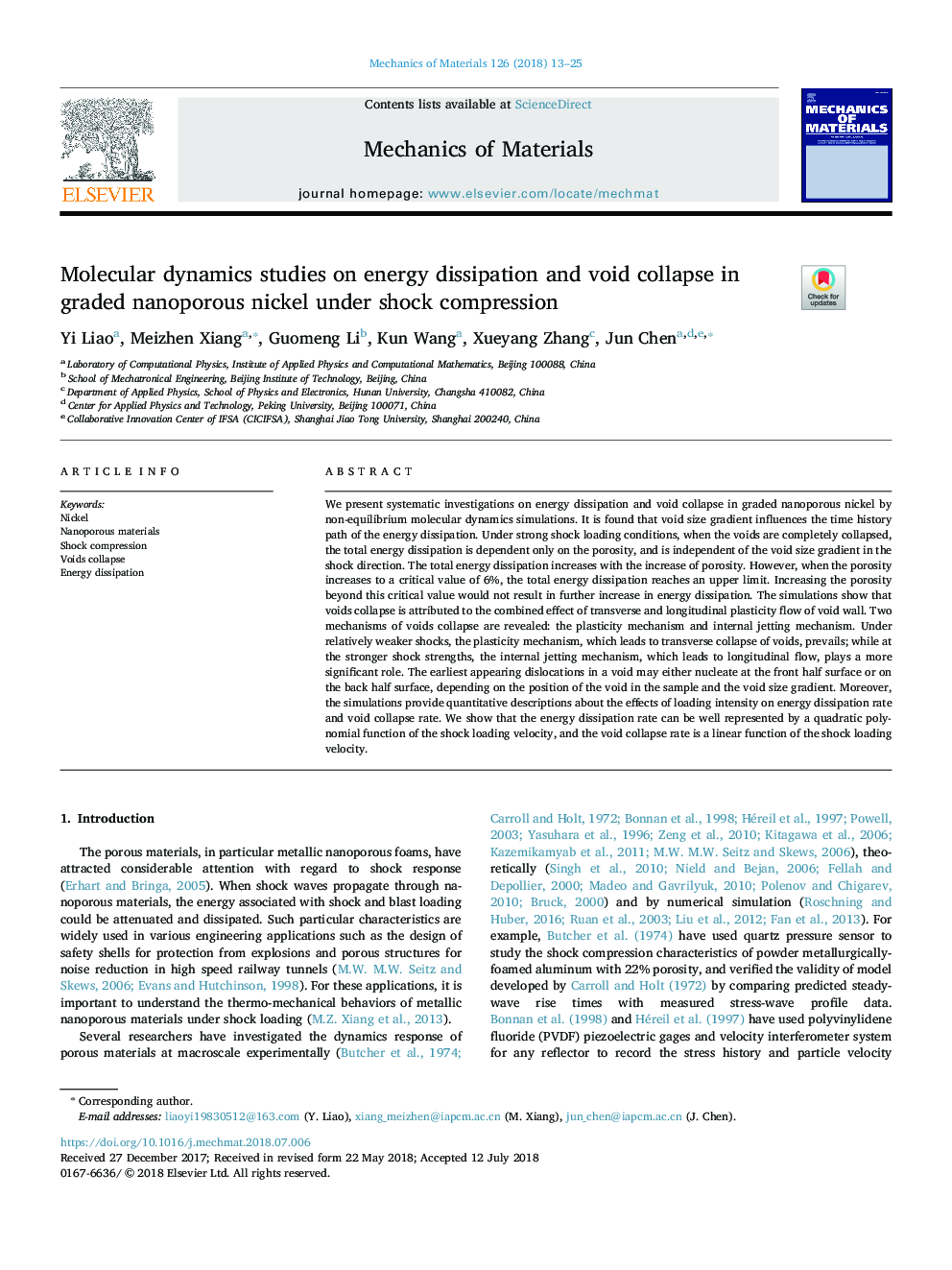| کد مقاله | کد نشریه | سال انتشار | مقاله انگلیسی | نسخه تمام متن |
|---|---|---|---|---|
| 7178462 | 1467413 | 2018 | 13 صفحه PDF | دانلود رایگان |
عنوان انگلیسی مقاله ISI
Molecular dynamics studies on energy dissipation and void collapse in graded nanoporous nickel under shock compression
ترجمه فارسی عنوان
مطالعات پویایی مولکولی بر روی تخلیه انرژی و فروپاشی خالی در نیکل نانو پودر تحت فشار فشرده
دانلود مقاله + سفارش ترجمه
دانلود مقاله ISI انگلیسی
رایگان برای ایرانیان
کلمات کلیدی
نیکل، مواد نانومقیاس، فشرده سازی شوک، سقوط می کند از بین بردن انرژی،
ترجمه چکیده
ما در حال انجام تحقیقات سیستماتیک در مورد تخلیه انرژی و فروپاشی خالی در نیکل نانو پودر درجه بندی شده توسط شبیه سازی های پویایی مولکولی غیر تعادل است. یافته شده است که شیب اندازه خالی بر روند تاریخچه زمان انحلال انرژی تاثیر می گذارد. در شرایط بارگذاری شوک قوی، زمانی که حفره ها به طور کامل سقوط می کنند، کل انرژی تخلیه تنها به تخلخل بستگی دارد و مستقل از گرادیان اندازه خالی در جهت شوک است. از بین بردن کل انرژی با افزایش تخلخل افزایش می یابد. با این حال، زمانی که تخلخل به یک مقدار بحرانی 6٪ افزایش یابد، میزان کل انرژی کاهش می یابد. افزایش تخلخل فراتر از این ارزش بحرانی باعث افزایش بیشتر در انحلال انرژی نمی شود. شبیه سازی نشان می دهد که سقوط حفره ها به اثر ترکیبی جریان پلاستیکی عرضی و طولی دیوار خالی مربوط می شود. دو مکانیسم سقوط حفره ها نشان داده شده است: مکانیزم پلاستیک و مکانیسم جابجایی داخلی. تحت شوک های نسبتا ضعیف، مکانیسم پلاستیکی، منجر به فروپاشی عرضی حفره ها می شود؛ در حالی که در قدرت های شوک قوی تر، مکانیسم جابجایی داخلی که منجر به جریان طولی می شود، نقش مهمی ایفا می کند. اولین زلزله های ظاهر شده در یک حادثه ممکن است در سطح نیمه جلو یا در سطح نیمه عقب، بسته به موقعیت خالی در نمونه و گرادیان اندازه خالی، به سمت هسته باشد. علاوه بر این، شبیه سازی ها توصیف کمی درباره اثرات شدت بارگذاری بر میزان انتشار انرژی و نرخ فروپاشی خالص ارائه می دهند. ما نشان می دهیم که سرعت تخلیه انرژی می تواند به خوبی با یک عمل چندجمله ای درجه دوم سرعت بارگیری شوک مطرح شود و نرخ فروپاشی خالی یک تابع خطی از سرعت بارگذاری شوک است.
موضوعات مرتبط
مهندسی و علوم پایه
سایر رشته های مهندسی
مهندسی مکانیک
چکیده انگلیسی
We present systematic investigations on energy dissipation and void collapse in graded nanoporous nickel by non-equilibrium molecular dynamics simulations. It is found that void size gradient influences the time history path of the energy dissipation. Under strong shock loading conditions, when the voids are completely collapsed, the total energy dissipation is dependent only on the porosity, and is independent of the void size gradient in the shock direction. The total energy dissipation increases with the increase of porosity. However, when the porosity increases to a critical value of 6%, the total energy dissipation reaches an upper limit. Increasing the porosity beyond this critical value would not result in further increase in energy dissipation. The simulations show that voids collapse is attributed to the combined effect of transverse and longitudinal plasticity flow of void wall. Two mechanisms of voids collapse are revealed: the plasticity mechanism and internal jetting mechanism. Under relatively weaker shocks, the plasticity mechanism, which leads to transverse collapse of voids, prevails; while at the stronger shock strengths, the internal jetting mechanism, which leads to longitudinal flow, plays a more significant role. The earliest appearing dislocations in a void may either nucleate at the front half surface or on the back half surface, depending on the position of the void in the sample and the void size gradient. Moreover, the simulations provide quantitative descriptions about the effects of loading intensity on energy dissipation rate and void collapse rate. We show that the energy dissipation rate can be well represented by a quadratic polynomial function of the shock loading velocity, and the void collapse rate is a linear function of the shock loading velocity.
ناشر
Database: Elsevier - ScienceDirect (ساینس دایرکت)
Journal: Mechanics of Materials - Volume 126, November 2018, Pages 13-25
Journal: Mechanics of Materials - Volume 126, November 2018, Pages 13-25
نویسندگان
Yi Liao, Meizhen Xiang, Guomeng Li, Kun Wang, Xueyang Zhang, Jun Chen,
